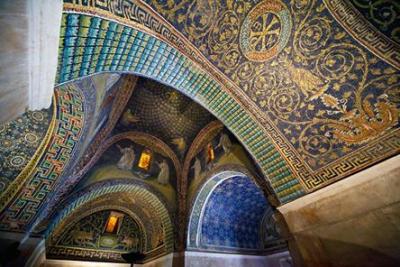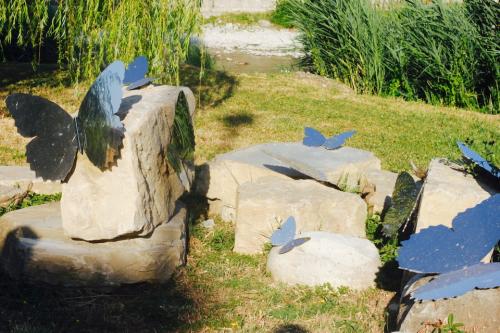Roaming through rich Romagna

FORLI -- “Tourist operators here in Romagna are now convinced they must promote the territory as a whole and not merely their own activity whether it be a hotel, beach establishment or whatever” says Fausto Faggioli who runs a farm where tourists can board and eat local products but has also had a big role in fostering a ‘whole territory’ mentality. Recently he invited me with other journalists to spend time at his farm and visit Romagna.
“The basis of this new mentality is a profound economic conviction – that globalisation harnesses powerful forces for standardization whereas we’re comparatively weak with few resources. But we have assets which cannot be standardized and can use the new means of communication to form a network which benefits us all –for instance, I’m one of about 700 farmers who collaborate in facing our problems. We share equipment such as tractors and I can call on the help of a pig farmer for the few pigs I have and the same goes for my bees.”
“There is a synergy which goes beyond our specific fields – I foster an appreciation of Romagna’s beach establishments and help tourists reach them swiftly even though my farm is in the Apennine foothills. Our greatest asset
Is the Romagnan’s warmth and conviviality which ensures that some tourists from other nations keep returning here for holidays year after year.”
Warmth and conviviality were not always associated with Romagna. Even up to the end of the second World War, Romagnans were often depicted as negatively as some southern Italians: violent, aggressive, anarchic, litigious rebels.
Geography has a large part in formation of a distinctive Romagna character: they were isolated between the Adriatic sea and the Apennines which reached the coast a bit south of Rimini. Above Ravenna they were separated from the Veneto region by extensive marshes.
The postwar boom broke down the isolation and enabled the better side of the Romagnan character to be known: their frankness and conviviality as illustrated in the stories of a local writer Giovanni Guareschi about the battles and friendship between a Romagnan Communist mayor and a Catholic priest. They have reacted to economic difficulties since 2008 with a new collaborative spirit.
In 1946 Romagna, a largely mountainous zone, was joined with flat Emilia to form the Emilia- Romagna region which, a few years ago, was nominated by Forbes magazine as the world’s region best for food- Romagna specializes in soft pasta, often in broth, pork dishes, rich cakes, cherries and apricots all washed down with the local San Giovese red wine.
Romagna ranges from wide beaches to thickly wooded mountains. Rimini is not only identified with comparatively inexpensive beach holidays but also has an intact historic centre with fine buildings such as Leon Battista Alberti’s Malatesta Temple. Ravenna was the capital of the Western Byzantine empire as testified by Byzantine –era churches with magnificent mosaics, such as San Vitale, while there are earlier monuments such as the tomb of the Empress Galla Placidia.
In recent years special efforts have been made to rejuvenate the townships in the Appennine valleys and hills. During the economic boom people left them for the bigger towns such as Forli, Rimini and Ravenna but now some have returned, aided by the European Union, back to these townlets which are often solid structures clustered around mediaeval castles or fortresses. Places such as Santa Sofia, which boasts a theatre designed by a leading architect Gae Aulenti and an open- air museum of sculpture on the banks of the river which winds through the town, or Bertinoro, renowned for its hospitality, which is called ‘the balcony of Romagna’ because its hillside looks out to the coast 20 kilometres away which stretches from Ravenna to Rimini.
The most controversial of these small towns is Predappio, nestled among green hills. It is the birthplace of Benito Mussolini who seems an embodiment of the negative stereotype of a Romangnans – rebellious and arrogant.
His mother was a teacher when the Predappio school was one of the settlement’s few solid buildings. His mother’s position enabled Mussolini to live in it during his formative years as a fervent Socialist. It is now the town hall. After coming to power in 1922, he built- up Predappio with the result that is an open- air museum of Fascist-era rationalist architecture. It also has several shops selling Fascists souvenirs such as clubs which were used against dissidents and other Fascist junk including a perfume archly called Nostalgia. Mussolini is buried in Predappio and on special occasions, such as the anniversary of the Fascist March on Rome to sieze power, it is overrun by Fascist supporters.
The mayor Giorgio Frassineti of the Democratic Party, who regrets that Predappio’s image is shaped by Fascists shopkeepers, has launched the idea of a Museum dedicated to Fascism. “It could hold interesting exhibitions, encourage study and research about Fascism to deepen our understanding of a phenomenon which was important to Italy and Europe.” says Frassineti “There are not many Fascists here and it is unfortunate that it is identified with Fascist grotesques. The museum would deepen our historical grasp of Fascism rather than concern current politics.”
It would contribute to the self-awareness of Romagna which is cultivating its traditions but is also very open to foreigners and the new. This is an interesting contrast with the Lega ( League) Party which is strong in the adjacent Veneto region where its attention to the local goes along with hostility to outsiders.
For further information: Fausto Faggiioli at ff@fattoriefaggioli.it and: ascom-forli@confcommercio.fo.it



